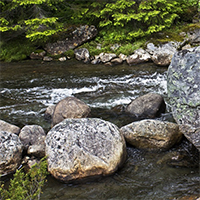Impacts of an extreme flood on the ecosystem of a headwater stream

Submitted: 2 December 2020
Accepted: 30 March 2021
Published: 8 April 2021
Accepted: 30 March 2021
Abstract Views: 1353
PDF: 406
Supplementary: 97
HTML: 21
Supplementary: 97
HTML: 21
Publisher's note
All claims expressed in this article are solely those of the authors and do not necessarily represent those of their affiliated organizations, or those of the publisher, the editors and the reviewers. Any product that may be evaluated in this article or claim that may be made by its manufacturer is not guaranteed or endorsed by the publisher.
All claims expressed in this article are solely those of the authors and do not necessarily represent those of their affiliated organizations, or those of the publisher, the editors and the reviewers. Any product that may be evaluated in this article or claim that may be made by its manufacturer is not guaranteed or endorsed by the publisher.
Similar Articles
- Elisa BURASCHI, Franco SALERNO, Chiara MONGUZZI, Giulia BARBIERO, Gianni TARTARI, Characterization of the Italian lake-types and identification of their reference sites using anthropogenic pressure factors , Journal of Limnology: Vol. 64 No. 1 (2005)
- A. Lami, N. Cameron, A. Korhola, Preface , Journal of Limnology: Vol. 59 No. s1 (2000): Climatic variability and ecosystem dynamics at remote mountain lakes
- Mau Trinh Dang, Hendrik Segers, La-orsri Sanoamuang, Rotifers from Thuy Tien lake and Nhu Y river in central Vietnam, with a description of Ploesoma asiaticum new species (Rotifera: Monogononta) , Journal of Limnology: Vol. 72 No. s2 (2013): Freshwater Invertebrates of Southeast Asia
- Roberto Bertoni, Journal of Limnology: of ancestors and descendants , Journal of Limnology: Vol. 75 No. 2 (2016)
- Barbara WICHT, Costanzo LIMONI, Raffaele PEDUZZI, Orlando PETRINI, Diphyllobothrium latum (Cestoda: Diphyllobothriidea) in perch (Perca fluviatilis) in three sub-alpine lakes: influence of biotic and abiotic factors on prevalence , Journal of Limnology: Vol. 68 No. 2 (2009)
- Anamarija Ridl, Marina Vilenica, Marija Ivković, Aleksandar Popijač, Ignac Sivec, Marko Miliša, Zlatko Mihaljević, Environmental drivers influencing stonefly assemblages along a longitudinal gradient in karst lotic habitats , Journal of Limnology: Vol. 77 No. 3 (2018)
- Airan dos Santos Protázio, Arielson dos Santos Protázio, Vivian Gama, Samantha Vieira Silva, Carla Giovanna Cruz dos Santos, Joanna Karine Gomes de Oliveira, Diet of tadpoles for five anuran species of northeast Brazil , Journal of Limnology: Vol. 79 No. 2 (2020)
- Bruno ROSSARO, Angela BOGGERO, Valeria LENCIONI, Laura MARZIALI, Angelo SOLIMINI, Tools for the development of a benthic quality index for Italian lakes , Journal of Limnology: Vol. 65 No. 1 (2006)
- Dmitry L. LAJUS, Victor R. ALEKSEEV, Phenotypic variation and developmental instability of life-history traits: a theory and a case study on within-population variation of resting eggs formation in Daphnia , Journal of Limnology: Vol. 63 No. s1 (2004): Diapause In Aquatic Invertebrates
- Mario MORI, Yuri PRETONI, Sebastiano SALVIDIO, Andrea BALDUZZI, Branchiobdellid size-crayfish size: a possible relationship , Journal of Limnology: Vol. 60 No. 2 (2001)
<< < 69 70 71 72 73 74 75 76 77 78 > >>
You may also start an advanced similarity search for this article.

 https://doi.org/10.4081/jlimnol.2021.1998
https://doi.org/10.4081/jlimnol.2021.1998






